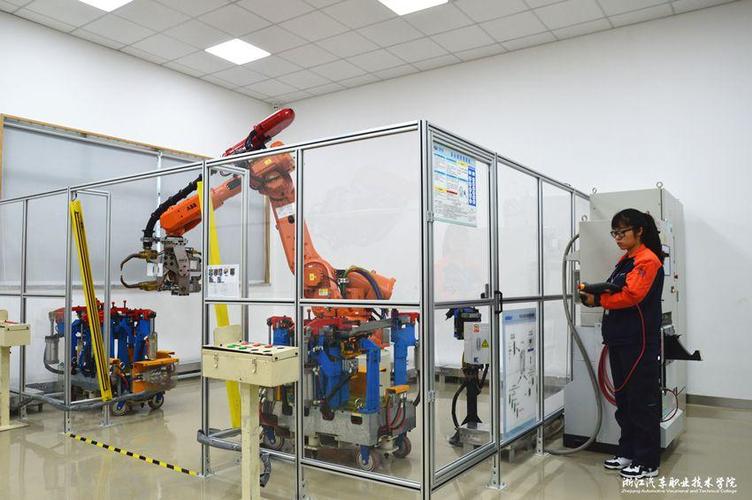您所在的位置:首页 - 科普 - 正文科普
c语言和机器人编程哪个好
![]() 漪珊
2024-05-06
【科普】
858人已围观
漪珊
2024-05-06
【科普】
858人已围观
摘要**Title:ExploringGuangyuanCLanguageRobotProgrammingPreviousExamQuestions**---InGuangyuan,theClanguag
Title: Exploring Guangyuan C Language Robot Programming Previous Exam Questions
In Guangyuan, the C language plays a crucial role in robot programming, being the backbone of many systems and applications. To delve into this domain, it's beneficial to review previous exam questions. Here, we dissect some typical questions, offering insights and guidance for aspiring C language programmers in the realm of robotics.
1. Understanding Basic Syntax and Control Structures
Question:
Explain the syntax of a 'for' loop in C language with an example. How is it utilized in robot programming?Answer:
In C language, a 'for' loop typically consists of three parts: initialization, condition, and increment/decrement. Here's a basic example:```c
include
int main() {
int i;
for (i = 0; i < 5; i ) {
printf("Iteration %d\n", i);
}
return 0;
}
```
In robot programming, 'for' loops are extensively used for iterative tasks such as sensor data processing, movement control, or trajectory planning. For instance, a 'for' loop might iterate through a series of sensor readings to make decisions based on environmental inputs.
2. Working with Functions and Modular Programming
Question:
Define a function in C language to calculate the factorial of a number recursively. How can modular programming enhance code readability and reusability in robot programming?Answer:
Below is a recursive function to compute the factorial of a number:```c
include
int factorial(int n) {
if (n == 0 || n == 1)
return 1;
else
return n * factorial(n 1);
}
int main() {
int num = 5;
printf("Factorial of %d is %d\n", num, factorial(num));
return 0;
}
```
Modular programming involves breaking down a program into ***aller, manageable modules or functions. In robot programming, this approach facilitates code maintenance, debugging, and scalability. For example, modularizing tasks such as sensor interfacing, motion planning, and decisionmaking allows for easier integration and modification of robot functionalities.
3. Memory Management and Pointers in Robotics
Question:
Explain the concept of dynamic memory allocation in C language using pointers. How is it relevant in robot programming, considering memory constraints?Answer:
Dynamic memory allocation in C involves requesting memory during runtime using functions like `malloc()` and `free()`. Pointers are utilized to manage this allocated memory. Here's a simple example:```c
include
include
int main() {
int *ptr;
ptr = (int *)malloc(5 * sizeof(int)); // Allocate memory for 5 integers
if (ptr == NULL) {
printf("Memory allocation failed\n");

return 1;
}
// Use ptr to access the allocated memory
// Don't forget to free the allocated memory
free(ptr);
return 0;
}
```
In robot programming, where memory resources are often limited, dynamic memory allocation is crucial for optimizing memory usage. Robots may need to handle varying amounts of data during operation, such as sensor readings or navigation maps. Efficient memory management ensures optimal performance and prevents memory leaks, which can be detrimental in longrunning robotic applications.
4. Handling Input/Output and Interfacing in Robotics
Question:
Discuss the significance of serial communication in robot control systems. Provide an example of serial communication implementation in C language for robot interfacing.Answer:
Serial communication, often facilitated through UART (Universal Asynchronous ReceiverTran***itter) or other protocols, is vital for realtime data exchange between robots and external devices such as computers, sensors, or other robots. Here's a basic example of serial communication in C using the `stdio.h` library:```c
include
int main() {
FILE *serial_port;
serial_port = fopen("/dev/ttyUSB0", "w"); // Open serial port for writing
if (serial_port == NULL) {
printf("Error opening serial port\n");
return 1;
}
fprintf(serial_port, "Hello, Robot!\n"); // Write data to serial port
fclose(serial_port); // Close serial port
return 0;
}
```
In robot control systems, serial communication facilitates tasks like sending commands to actuators, receiving sensor data, or interfacing with external controllers. Robust serial communication implementations are essential for reliable and efficient robotic operations.
Conclusion
Robot programming in Guangyuan, particularly using the C language, demands a solid understanding of fundamental concepts and their practical applications. By dissecting previous exam questions and understanding their relevance in the context of robotics, aspiring programmers can enhance their skills and contribute effectively to the field of robotic engineering.
Tags: 机器人编程是用c语言吗 c语言机器人编程代码 机器人编程与c语言编程的区别 c语言运行机器码 c语言和机器人编程哪个好
版权声明: 免责声明:本网站部分内容由用户自行上传,若侵犯了您的权益,请联系我们处理,谢谢!联系QQ:2760375052
上一篇: 石家庄科技信息职业学院招生简章
下一篇: 电商扶贫宣传广告语
最近发表
- 探索日本核污染水排放,现状、影响与应对策略
- 全职妈妈离婚获2万元经济补偿,揭秘背后的真相与启示
- 王琳惊艳亮相,54岁穿短裙婚纱走秀的优雅与活力
- 继续深耕中国,共创共享机遇
- 千位歌迷在刀郎演唱会现场外,音乐盛宴如梦如幻
- 渔船遇海盗袭击,3名中国人失踪,紧急救援与深入理解
- 小米试驾体验遇尴尬,雷军秒道歉引热议
- 香港歌手李国祥去世
- 音乐人因刀郎跨越西洋乐与中国音乐的奇妙转变——深度解读与启示
- 清华毕业生失踪背后的罗生门,揭开真相与寻找答案
- 韩国救山火消防员盒饭,一份充满人间温情的瞬间
- 黄金价格的终极目标,探寻价值与投资方向
- 小区惊魂,儿童车祸事故的警示与启示
- 湖南38个机关事业单位围墙全拆,开启新篇章
- 车主掉头遇红灯,后车滴滴巧应对
- 探索云南曲靖市会泽县的地震事件
- 新郎没拉裤子拉链,新娘手动闭链的浪漫婚礼
- 10岁女孩高烧去世,被诊断为7种疾病
- 拥抱与冒险,两个小孩的温馨瞬间与泥坑的奇妙旅程
- 女厅官落马后,下属被查风波掀起波澜
- 勇敢逆行,诠释人间大爱——关于溺亡外卖员及其家庭的故事
- 大摩小摩去年四季度疯狂买A股
- 从人去楼空歌词中读懂离别的深情与生命的哲思
- 甲亢患者学功夫之路,挑战与成长
- 九牛一毛歇后语——生活中的小智慧大道理
- 多名大陆配偶被限期离台 台各界发声
- 和巧虎一起玩躲猫猫,让孩子在游戏中学习与成长!
- 王者荣耀游戏体验优化与应对关键问题的应对策略
- 探索趣味与成长的数字乐园
- 地震的力量,缅甸与汶川地震的对比
- 畅享军事模拟游戏的无限乐趣
- 缅甸地震,灾难中的救援与应对
- 董宇辉报平安,温馨时刻
- 机战王洛洛历险记全集——一场童年的奇幻冒险之旅
- 揭开美军飞行员之怒,深入了解行为后果与安全责任
- 揭开全国重名查询系统的神秘面纱,如何轻松找到与你同名的人
- 缅甸地震中的救援行动与启示
- 揭秘你的另一个星座,探索隐藏的性格密码
- 东旭集团证券违法拟被罚17亿元
- 深入解析暗黑破坏神攻略,助你成为圣休亚瑞的传奇英雄
- 专家解读地球是否进入活跃期文章标题
- 畅玩经典——实况足球10中文版的全面解析与攻略
- 牛肉市场中的中方与美国厂商,续约与挑战
- 畅玩捕鱼达人单机版,轻松体验水下冒险的乐趣
- 王钰栋应对脚踝受伤,回应与处理
- 探索自然的灯塔——野外女教师的角色与魅力
- 华阳集团,2024年净利润增长引领行业新篇章
- 探索南美大陆的地理瑰宝
- 男子做马拉松陪跑一场收入6000元
- 69岁阿姨的退休生活,自驾游的传奇之旅文章标题及内容


